With this summer’s record-breaking heat across much of the U.S., you may find yourself spending more time in the sun, which increases your risk for melanoma, a less common but dangerous form of skin cancer. Pictures of melanoma show how these cancerous moles sometimes blend in with benign birth marks.
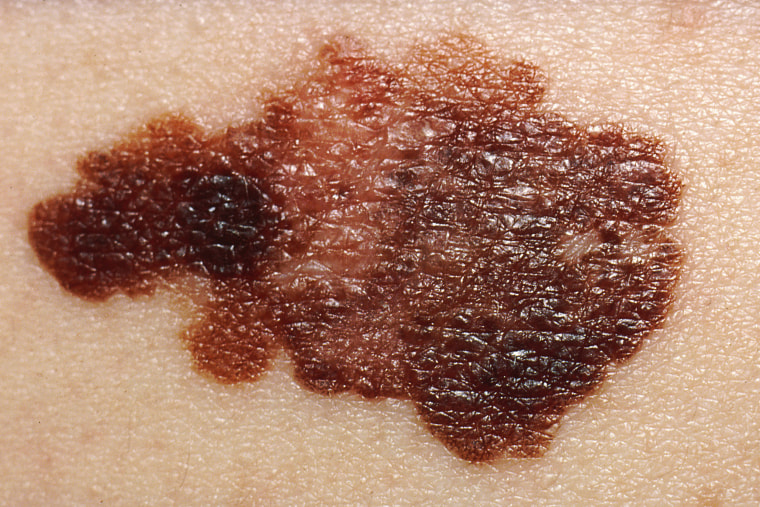
While you may be less likely to develop melanoma than other types of skin cancers, melanoma can spread to other parts of the body more easily. Here’s what to know about this type of skin cancer.
What is melanoma?
Melanoma is a type of cancer that affects the top layer of your skin. This layer contains cells, called melanocytes, that create the pigment that gives your skin its color. Melanoma occurs when these cells grow out of control.
The Skin Cancer Foundation predicts 186,680 people in the U.S. will be diagnosed with melanoma in 2023 — and 7,990 people will die from it.
“It’s the biggie of the skin cancers. It’s the one we’re most worried about — and that’s most scary for most patients,” Dr. Amy McMichael, dermatology professor at Wake Forest University School of Medicine and member of the American Academy of Dermatology, tells TODAY.com.
Early detection is critical. The Skin Cancer Foundation recommends an annual skin exam by a dermatologist, and you may need more frequent screening if you are at higher risk. According to the Skin Cancer Foundation, the survival rate for melanoma is more than 99% for people in the U.S. when it's discovered early, before it spreads to the lymph nodes and other organs.
Risk factors for melanoma
People with light skin, especially if they get freckles or sunburns easily, are at higher risk for melanoma. But everyone, regardless of skin color, is can develop this deadly disease. “We see it in patients with darker skin types as well,” said Dr. Ivy Lee, a dermatologist and member of the American Academy of Dermatology.
According to the American Cancer Society, you’re also at higher risk for melanoma if you have:
- A lot of skin moles or if you have larger moles that are an abnormal shape or color.
- A parent, sibling or child with a history of melanoma. McMichael explained that some people have a genetic predisposition to melanoma. “Melanoma is one of those cancers where we are really starting to look at the genetics,” she said.
- UV exposure from the sun or tanning beds, especially if you had frequent sunburns when you were a child.
- Already had melanoma or basal or squamous cell skin cancer.
- A weakened immune system.
- A rare condition called xeroderma pigmentosum.
Symptoms of melanoma
Since the abnormal cells in melanoma create pigment, most of the time, with melanoma you’ll develop one or more tumors that are black or brown. The symptoms of melanoma can also sometimes be pink, tan or white tumors, according to the ACS.
Melanomas are often found on the chest and back in men and on the legs in women. People with darker skin are at lower risk of developing melanoma in these places. But melanoma can also appear on the palms, soles of the feet, fingernails and other parts of the body in people with skin of any color. “Melanoma is more common on the hands and feet of patients of African descent,” said McMichael.
The ABDCE rule is a common way to tell whether a mole may be melanoma.
Melanoma pictures
The ABDCE rule, as well as pictures of melanoma, can help you identify whether you should see a doctor for your mole. But when in doubt, always contact a dermatologist.
A stands for asymmetry, when one half of the mole doesn't match the other. In the below picture of a melanoma, you can see the left half is raised, unlike the right half.

In the below image of a mole, its shape is slightly asymmetrical, but it is not a melanoma.

B stands for border, because melanomas often have an irregular border. In the below picture of a melanoma, you can see the border doesn't seem to follow any pattern and is very irregularly shaped.
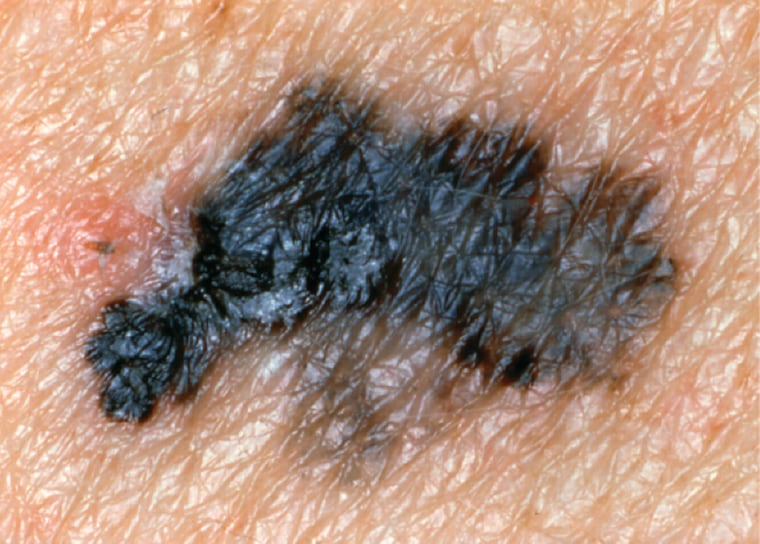
The benign mole in the below image has a border that is not perfectly consistent, but it's quite circular compared to the above picture of the melanoma.
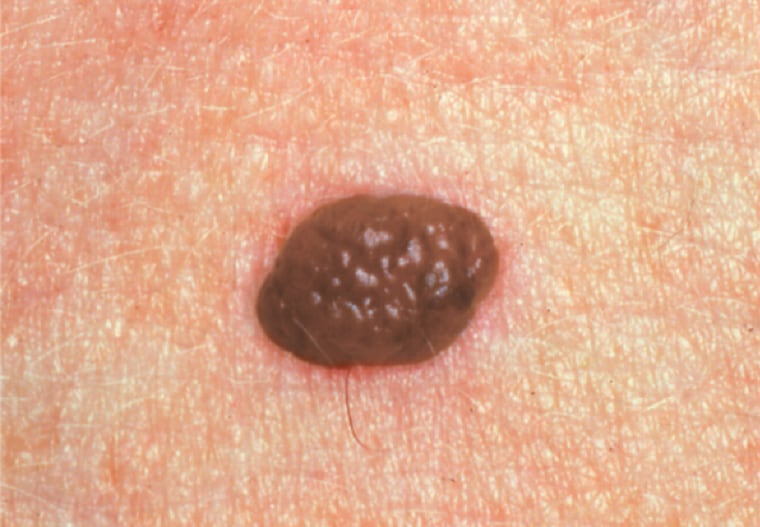
C stands for color. Melanomas often have different colors within the mole, such as different shades of black, brown or even pink, red, white or blue. The below image of a melanoma has visible spots that are much lighter than others, as well as dark-brown splotches.
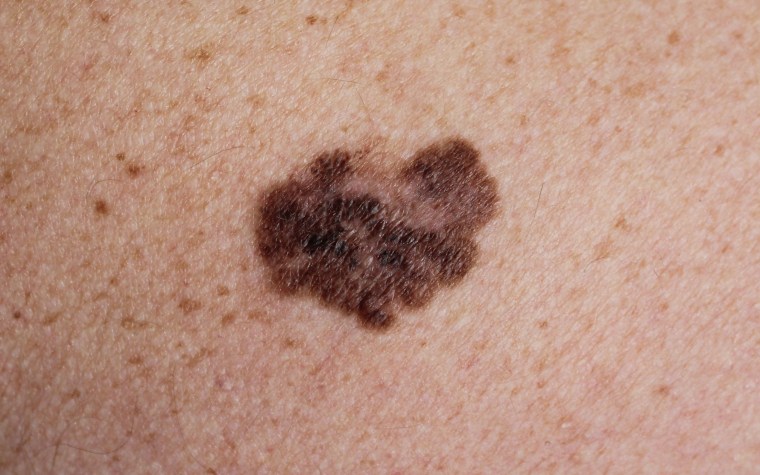
The below image of a benign mole has slightly different shades of brown within it, but overall the colors are much more similar than in the above image.
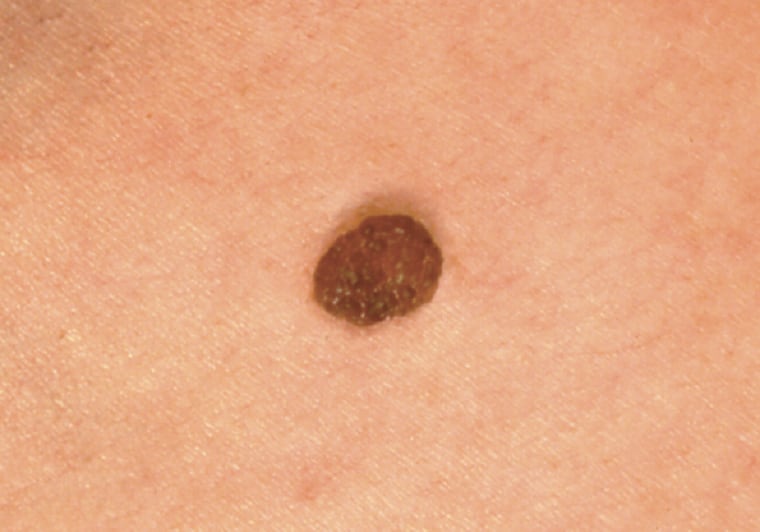
D stands for diameter. Melanomas often have a diameter of greater than one-quarter inch, about the size of a pencil eraser. Below is a picture of a melanoma that is bigger than one-quarter of an inch.
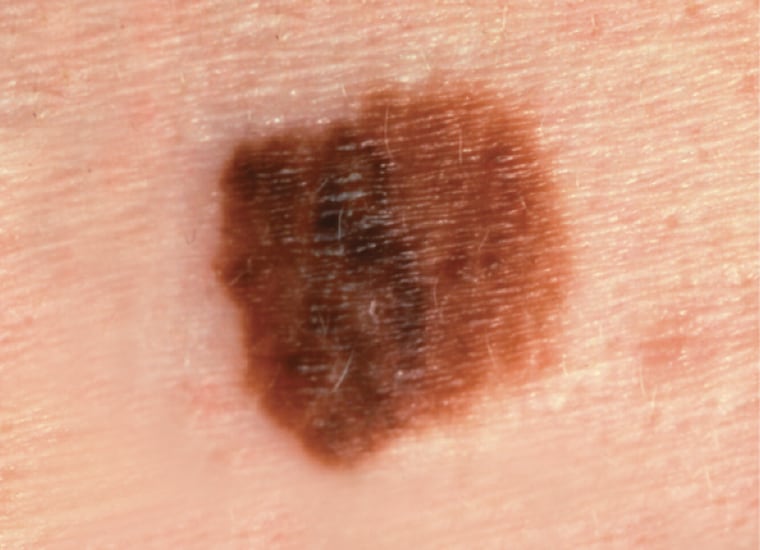
Below is a picture of a noncancerous mole that may appear larger than the size of a pencil eraser but is actually benign.
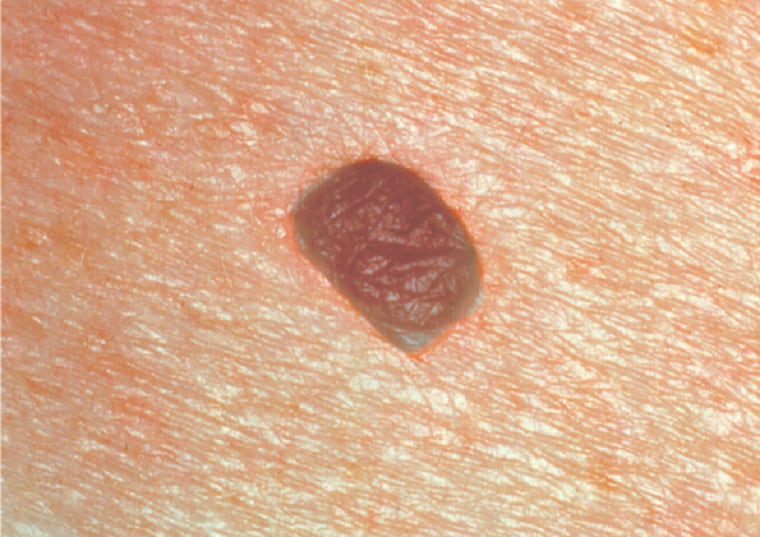
E stands for evolving. This means the mole changes in size, shape or color as time passes. The below image shows how a melanoma changed in shape and border over the course of two years.

Causes of melanoma
Ultraviolet light exposure from the sun or from tanning beds causes most melanomas. Melanoma may appear at a spot where you have an existing mole.
But if an unusual spot shows up on your skin, get it checked out even if it’s not connected to a mole. The Skin Cancer Foundation reports that only 20 to 30% of melanomas start as existing moles. That means that 70 to 80% develop on skin that appeared to be normal.
“Be familiar with the constellation that’s on your skin,” Lee says. “You don’t need to memorize every mole or birthmark, but get familiar with the canvas so if anything is new, your eye is more attuned to it.”
People sometimes think the spot they see on their skin is a new mole, ink mark or bruise, and they delay getting it checked. If something on your skin looks different, it’s best to have it checked out, Lee adds.
Diagnosing melanoma
If your dermatologist suspects melanoma, they can biopsy the suspicious area and send it to a lab for examination. If it turns out to be melanoma, your doctor may run blood tests and imaging scans to see how advanced the cancer is — and to grade it.
According to the American Cancer Society, melanomas are graded on a scale of stage 0 to 4, with stage 4 being the most advanced. Some stages also have a letter designation, such as A, B or C. Later letters correspond with more advanced cancer within that stage.
Staging takes into consideration:
- How thick the tumor is
- Whether the skin over the tumor is broken down (ulcerated)
- Whether the cancer has spread to nearby lymph nodes
- Whether the cancer has spread to lymph nodes that are further away, or to other locations such as the lungs, liver, brain, bones or other skin locations
Treatment for melanoma
Treatment for melanoma depends on how advanced it is and where the tumor is located. McMichael says doctors will look at the tumor’s depth, how quickly cells are dividing and other factors to help make treatment decisions.
The Skin Cancer Foundation says treatment options include:
- Surgery
- Immunotherapy
- Targeted therapy
- Chemotherapy
- Radiation
Many people with melanoma will see an oncologist and surgical oncologist along with a dermatologist. “This is not one we want to manage alone,” McMichael says.
Reducing melanoma risk
You can reduce your risk of developing melanoma by reducing your exposure to UV radiation.
The Skin Cancer Foundation recommends that you:
- Cover up with clothing
- Stay in the shade, especially between 10 a.m. and 4 p.m.
- Use a broad-spectrum sunscreen with an SPF of 15 or higher every day
- Use a broad-spectrum, water-resistant sunscreen with an SPF of 30 or higher if you’re going to be out in the sun for a while